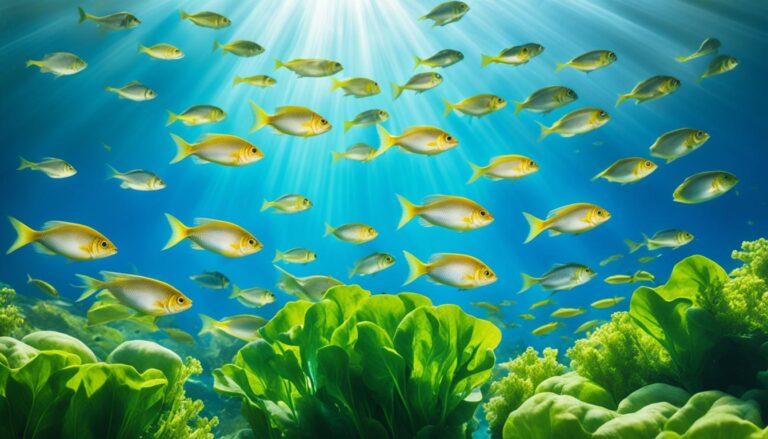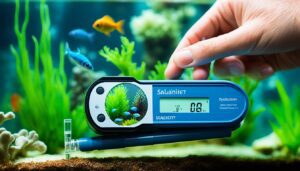I love fish and their underwater world. The idea of fish fasting is something many experts talk about. It means not feeding your aquarium fish for one to two days a week. This helps mimic their natural living conditions and is beneficial.
Many people who keep fish find this fasting method good for the fish’s health. Research shows that the timing of feeding fish affects their well-being. This is why there’s a lot of interest in a detailed fish fasting guide.
In nature, fish often go without food. Mimicking this in an aquarium can make it healthier. Knowing how to do fish fasting right helps your fish and the whole tank. It’s much like how fasting benefits humans, such as lowering heart risks and boosting metabolism.
The main goal of fish fasting isn’t to harm your fish. It’s about making their lives better and more colorful. Let’s explore how we can do fish fasting the right way. It’s great for our fish friends and our tanks.
Fish Fasting and Its Significance
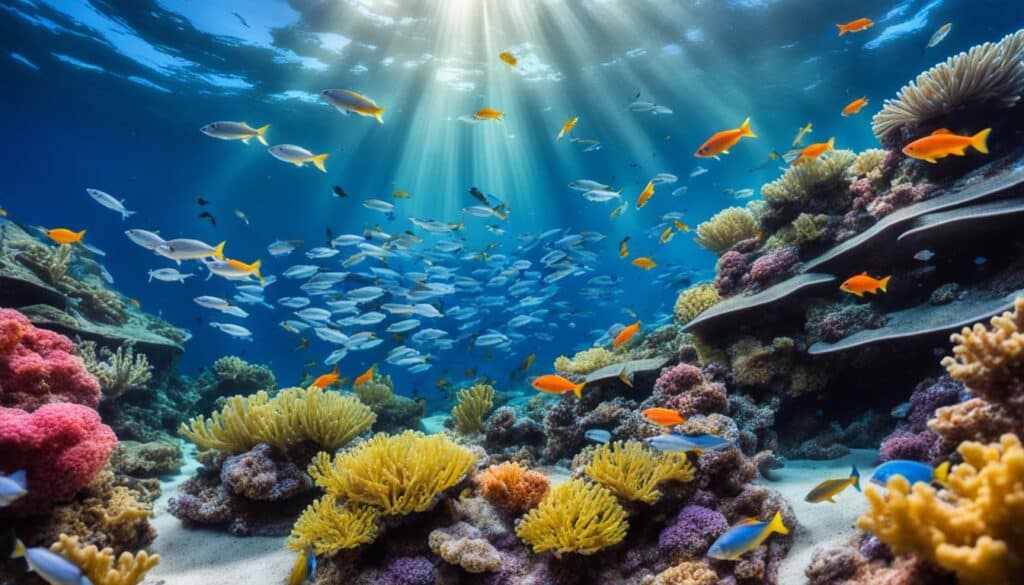
Fish fasting connects deeply with traditions around the world. It shows us the global importance and benefits of not feeding fish. Learning about its history helps us see why it’s key for healthy waters and a better environment today.
Demystifying Fish Fasting Myths and Facts
Many people misunderstand fish fasting. They think it’s bad for fish in aquariums. But skipping meals on purpose is actually good. It copies what happens in nature. This makes fish healthier and the water clearer.
Why Fish Fasting is Important for Aquatic Health
Fish fasting is more than just skipping feedings. In the wild, fish often go without food. This break helps them digest better and stay healthy.
Doing the same in aquariums can stop problems caused by too much food. This includes dirty water and sick fish. This shows why fish fasting is good.
Comparing Fish Fasting with Traditional Feeding Practices
There’s a big difference between fish fasting and regular feeding. Regular feeding overlooks the natural breaks fish take from eating. This can stress them out and make them sick.
Fasting Practice |
Benefits |
Common Misconceptions |
|---|---|---|
Traditional Feeding |
Consistent growth, Immediate gratification |
Overfeeding leads to health issues |
Fish Fasting |
Healthier metabolism, Mimics natural conditions |
Considered harmful without proper knowledge |
Understanding fish fasting is key to keeping fish and their homes healthy. It also makes aquariums better for the environment. Adding fish fasting to care routines can improve life for our aquatic friends and their ecosystems.
Identifying When Fish Fasting is Necessary
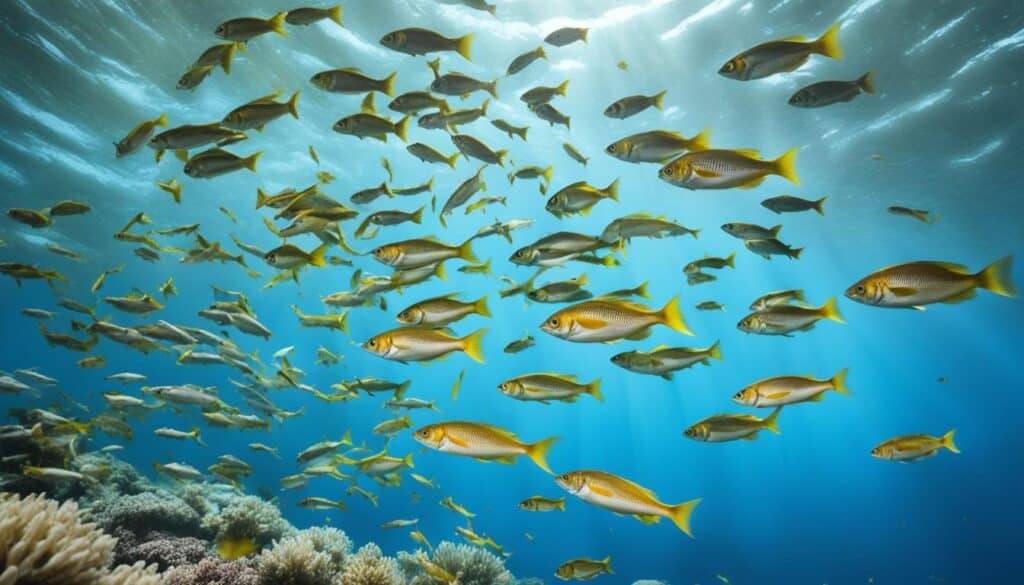
Knowing when to fast your fish is key to keeping a healthy aquarium and happy fish. It’s about spotting signs of too much food and changing how often you feed them. This can lead to a better environment and stop health problems. Let’s look at the main signs and times when fasting your fish is a good idea.
Watch your fish and tank carefully. If you see uneaten food, murky water, or high ammonia or nitrite, it’s time to think about fasting. These signs can mean your tank is polluted. This hurts the fish and can mess up the tank’s balance.
- Fish with swollen bellies may have eaten too much.
- Fasting helps them digest better and eat like they would in the wild.
- At night, some fish like kuhli loaches or plecos might get too much food. Consider fasting them.
Fish fasting is more than stopping overfeeding. It mimics how fish eat naturally, when food isn’t always there. This can help fish like carnivores, who naturally eat less often, stay healthy. But, remember, fish that graze all day need to eat more often.
Here are some tips for fish fasting:
- Fasting once or twice a week is good for adult fish with slow metabolisms.
- Don’t fast young or very active fish. They need more food to grow and stay healthy.
- Make sure your fasting plan fits the fish species and their needs.
Adding fasting to your fish care routine takes care and knowing your fish well. Learning to read your fish and tank will make your aquarium more lively and healthy.
Essential Benefits of Fish Fasting
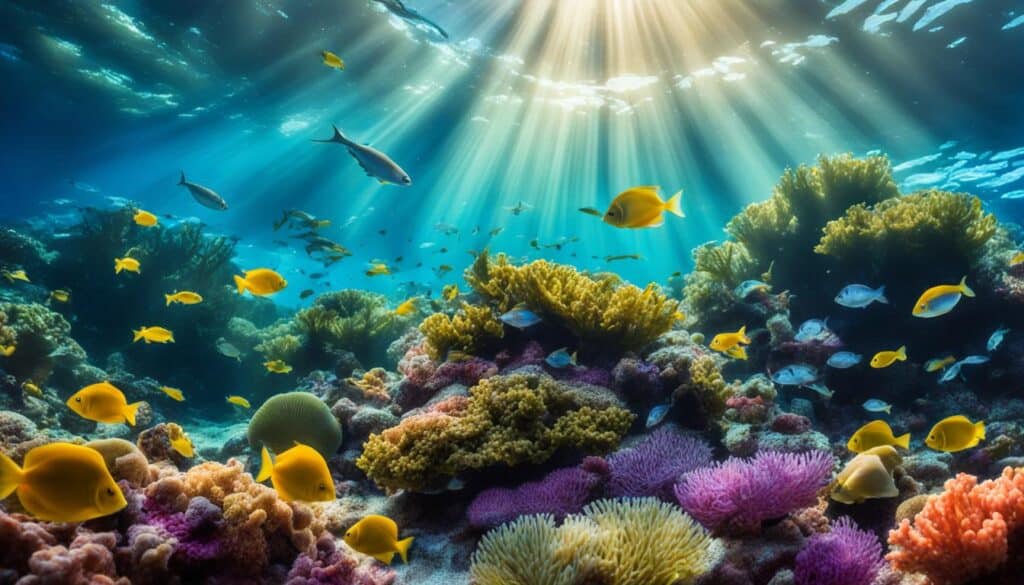
The fish fasting diet offers health and environmental upsides. It improves life underwater and our health. By not feeding fish for periods, especially in tanks, we see big wellness wins.
Improving Tank Water Quality Through Fasting
Benefits of fish fasting include better tank water. It cuts down left-over food and waste. This results in clearer water and fewer bacteria. So, tanks need less cleaning and fewer chemicals.
Health Benefits Associated with Periodic Fish Fasting
Fish fasting is great for fish health. It stops fish from overeating, preventing fatness and liver issues. Fasting also boosts digestion and cell renewal. This can make fish live longer and healthier.
Fasting is good for fish, just like it is for humans. It enhances metabolism and lowers toxin build-up. This leads to a happier, healthier fish family.
If you have an aquarium or take care of big water areas, try a fish fasting diet. This ensures better water and healthier fish. It’s a step towards a thriving water world.
Challenges of Fish Fasting
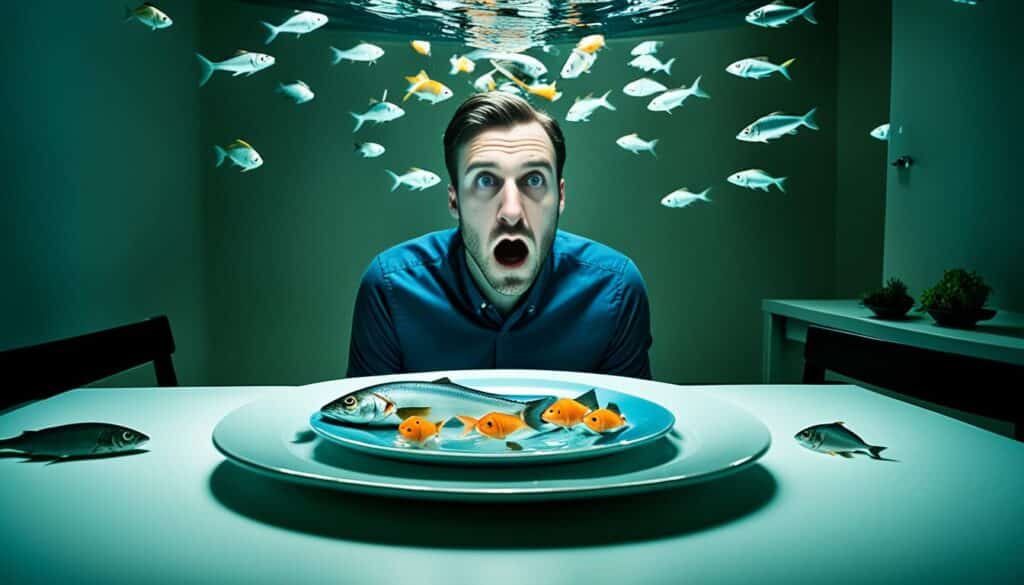
Starting a fast for fish can seem hard because of the need for precise feeding control. There are also health risks if it’s not done right. Knowing these issues is key for anyone wanting to try fasting with fish.
Navigating the Optimal Duration and Response
Finding the right length of fast for fish is tricky. Their intestines are simple and can’t handle too much food all at once. This makes choosing how long to fast them very important.
Watching how fish act during fasting is vital. It helps make sure they aren’t stressed or too hungry. This observation is key to a successful fast.
Keeping water quality top-notch is crucial for fasting. Bad water is a major disease source. So, clean water is a must during fasting times. This includes keeping the water at the right temperature. Even small changes can upset fasting fish.
Health Monitoring
Not feeding fish regularly makes tracking their health harder. Overfed fish, like the betta, can get really sick. So, it’s important to watch for any health issues while they fast. Fish vets are great help. They can give advice and care that’s just right for fasting fish.
Adapting to Intrinsic and Environmental Changes
Fish react to both internal signals and what’s happening around them. These affect how they feed. When fasting, it’s key to get these cues right. This helps keep them healthy and ready to eat again once the fast ends.
Aspect |
Challenge |
Consideration |
|---|---|---|
Duration |
Determining optimal fasting time |
Monitor fish behavior closely |
Water Quality |
Maintaining pristine conditions |
Regular testing and adjustments |
Health Monitoring |
Detecting signs of distress |
Consultation with a fish veterinarian |
Environmental Factors |
Adapting to changes |
Understanding intrinsic signals |
In conclusion, doing fish fasting right needs a deep knowledge of their environment and health. With careful handling of these challenges, fasting can help improve our fish’s lives.
Step-by-Step Guide on How To Do Fish Fasting

If you want to know how to do fish fasting, you’re in the right place. We’ll guide you through each step to make it easy and beneficial for your fish. By following these steps, you’ll keep your fish healthy and their home clean.
Preparing for the Fish Fasting Period
First, look at your fish’s feeding schedule and what they eat. For example, young goldfish might eat three times a day, while older ones may need just twice. Aim to feed them an amount the size of their eyeball or 1% of their body weight. Also, make sure the water in your tank is clean. Good water quality is very important during fasting.
Monitoring Fish Behavior and Health During Fasting
Keep an eye on your fish when they are fasting. Watch how they act and look for any health changes. If you see strange poop colors or sizes, it might mean they have stomach problems. If your fish seem uncomfortable, like they’re bloated or constipated from eating certain foods, you might need to make some changes. Feeding them high-quality food like New Life Spectrum, Repashy, and Saki Hikari can help keep them healthy.
Gradually Resuming Feeding After the Fasting Interval
When it’s time to feed your fish again, start slowly. Offer them foods that are easy to digest, like soft vegetables or live foods that don’t carry diseases. Taking it slow helps their stomachs get back to normal and keeps them healthy after fasting.
Fish Fasting Tips: Always take out food that’s not eaten, whether it’s pellets, flakes, or gel. This stops overfeeding and keeps your tank clean. Doing this makes your fish fasting plan work well for your underwater buddies.
Food Type |
Feeding Frequency (Juveniles) |
Feeding Frequency (Adults) |
Precautions |
|---|---|---|---|
Pellets |
3 times daily |
2 times daily |
Remove uneaten food promptly |
Flakes |
3 times daily |
2 times daily |
Monitor for air swallowing leading to bloat |
Live food |
2 times daily |
1 time daily |
Ensure it’s disease-free |
Vegetables |
With weekly meals |
With weekly meals |
Blanch to ease digestion |
Sticking to this fish fasting guide turns fasting into a positive step. It’s not just a routine but a way to make your fish and their environment healthier. This makes fasting a key part of taking care of your aquarium.
Practical Fish Fasting Tips for Aquarium Enthusiasts
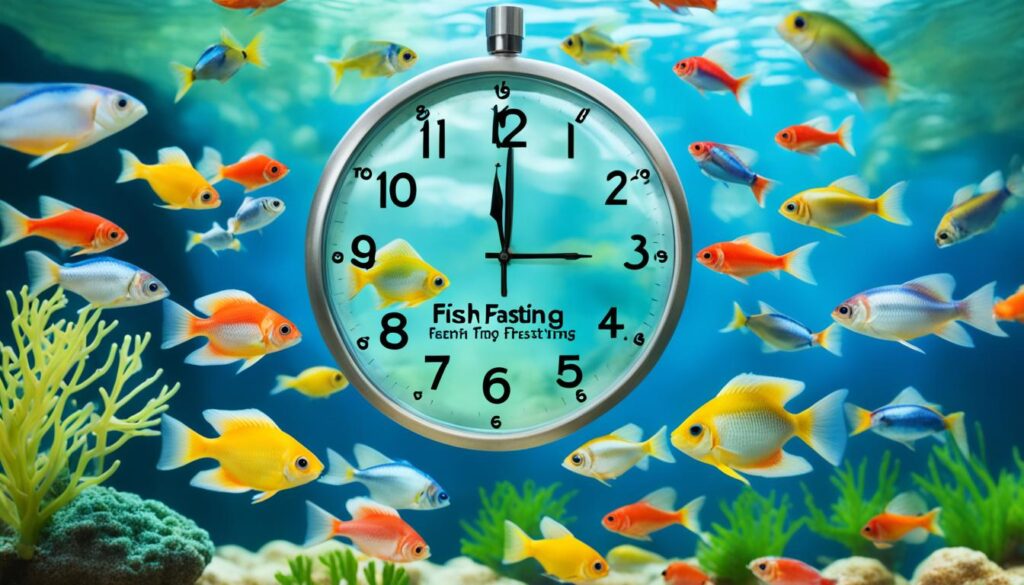
For aquarium lovers, knowing when to feed and when to fast your fish is key. In this guide, I’ll dive into some effective fish fasting tips. These tips have helped me keep a healthy aquarium and enjoy the benefits of fish fasting.
Optimal Fish Fasting Duration and Frequency
Getting the right fish fasting for health schedule is important. Adult fish can often skip meals for up to two weeks. But baby fish need to eat a lot, about 3-8 times daily. On the other hand, older fish only need food 2-7 times a week. Eating less cuts down on waste, which keeps the tank clean and your fish happy and healthy.
Effective Tank Maintenance During Fasting Phases
While your fish are fasting, it’s a great time to take care of the tank. Fewer bits of leftover food mean less mess. Keep an eye on the water quality, as it might change when you feed your fish less. Let’s weigh the pros and cons of some feeding tools you might find handy during fasting:
Tool |
Cost |
Description |
|---|---|---|
Professional Fish Sitter |
$20 per hour and up |
Best for personalized care. Great if you’re away for a long time and want someone to look after your aquarium closely. |
Casual Fish Sitter |
Approximately $10 per visit |
An affordable way to make sure your fish get fed and checked on. Good for shorter breaks. |
Automatic Fish Feeder |
$25-$60 |
Keeps feedings consistent. A must-have for ensuring your fish eat regularly, especially if they’re very active. |
Vacation Fish Feeder Block |
$2-$6 |
Feeds your fish for up to 14 days. Perfect for when you can’t monitor the fasting yourself. |
Fish fasting isn’t just about not feeding them. It’s also about giving their health a boost. By following these fish fasting tips, you’re sure to see a happier, more vibrant aquarium life.
Fish Fasting to Address Specific Health Concerns
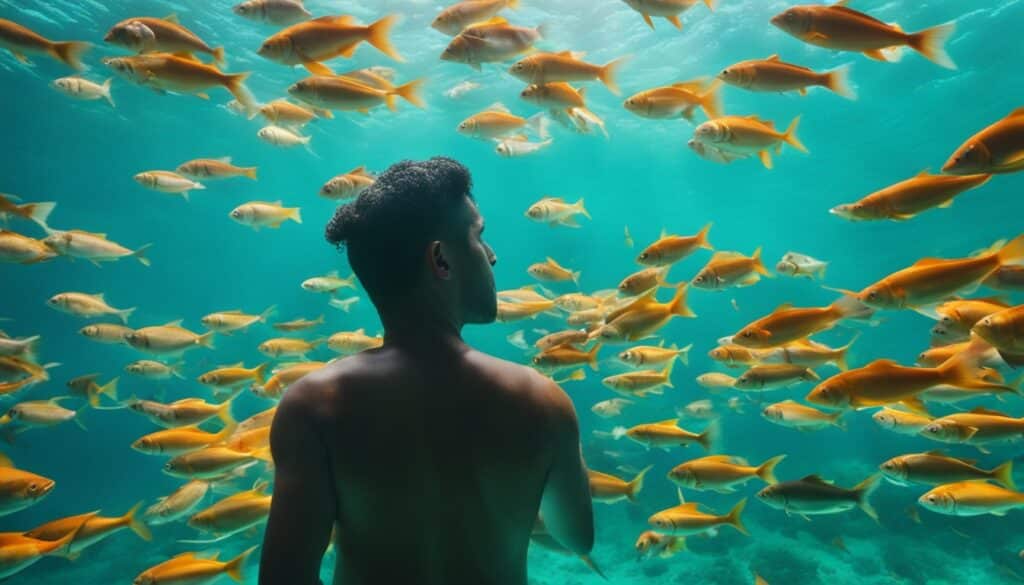
Making fish fasting a part of your aquatic pets’ diet can lead to big health benefits. It’s more than just skipping meals. It’s about improving their health and tackling specific problems they face.
Studies show fasting helps fish just like it does other animals. It can lower blood sugar, cut down on cholesterol, and fight diseases that come with age. For young fish, like the Killifish, fasting can turn on important genes that don’t show up in older fish. Yet, fasting can be harmful for older fish because it might lead to more inflammation which is bad for their tissues.
It’s key to know when and how to start a fish fasting diet. Here’s what you need to keep in mind for different fish needs:
- Occasional fasting is good for young fish. It can help them live longer, healthier lives.
- Older fish do better with short fasting periods often. This can lower the chance of inflammation.
- The fasting schedule should match the specific needs of the fish. Big fish like Goldfish and Koi can go longer without food because of their fat stores.
Fasting is not just good for health. It also stops overfeeding, a big problem in fish tanks. A good fasting plan helps with digestion and metabolism. This makes for happier, more active fish.
Fish can go days to weeks without eating, depending on the type. But fasting for too long isn’t good. It can cause weight and muscle loss, and make fish more aggressive. Watching how they react to fasting helps keep them healthy while avoiding risks.
Adding a well-planned fish fasting diet can boost fish health and energy. It’s about meeting their unique needs and life stages.
The Role of Diet: Choosing the Right Nutrition Post-Fasting
Starting to eat again after a fish fasting period is crucial. It’s all about the balance needed after fasting to keep up the benefits of fish fasting. Humans do intermittent fasting, which includes 12 to 48 hours of fasting regularly. It’s key that the next meals don’t overwhelm the fish. Using the same idea, the shift back to a regular fish fasting diet needs careful thought. The aim is to give high-quality, nutrient-rich food. This helps maintain the fish’s health and avoids returning to previous overfeeding.
When thinking about the food after fasting, a balanced diet is key. Multivitamins, lean proteins, and omega-rich oils like those in fish or algae are best. They have few calories but support healthy metabolism. For fish care, reintroducing food should follow these guidelines. The focus should be on high-quality, easy-to-digest nutrients. This way, we can hold on to the benefits of fish fasting.
Different human diet studies, like the Daniel Fast or protein restriction, show how diet changes can improve health. Such diets can affect glucose levels, metabolic functions, and brain performance. Using this idea for fish care means custom diets after fasting. This meets their specific needs, prevents overfeeding, and aims to boost their health and lifespan.
